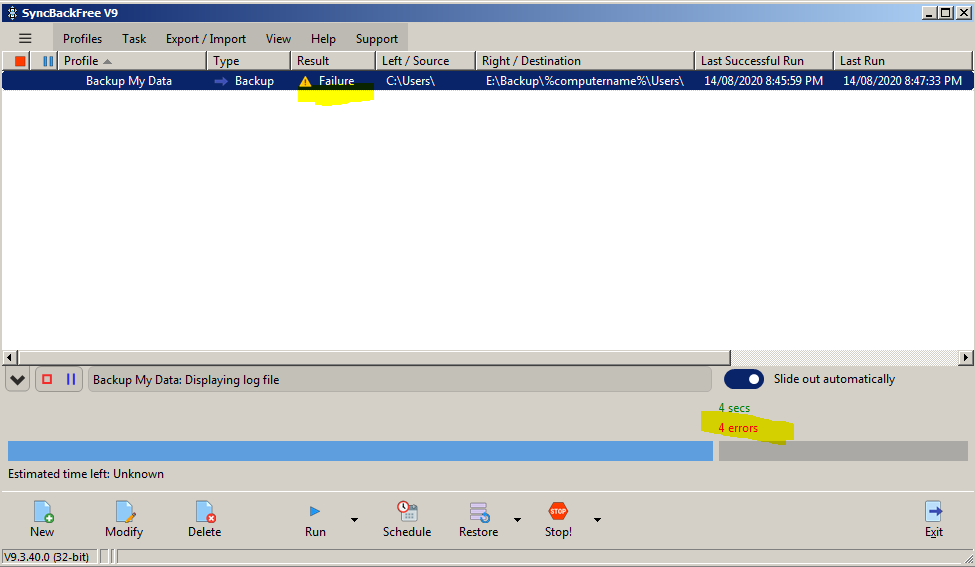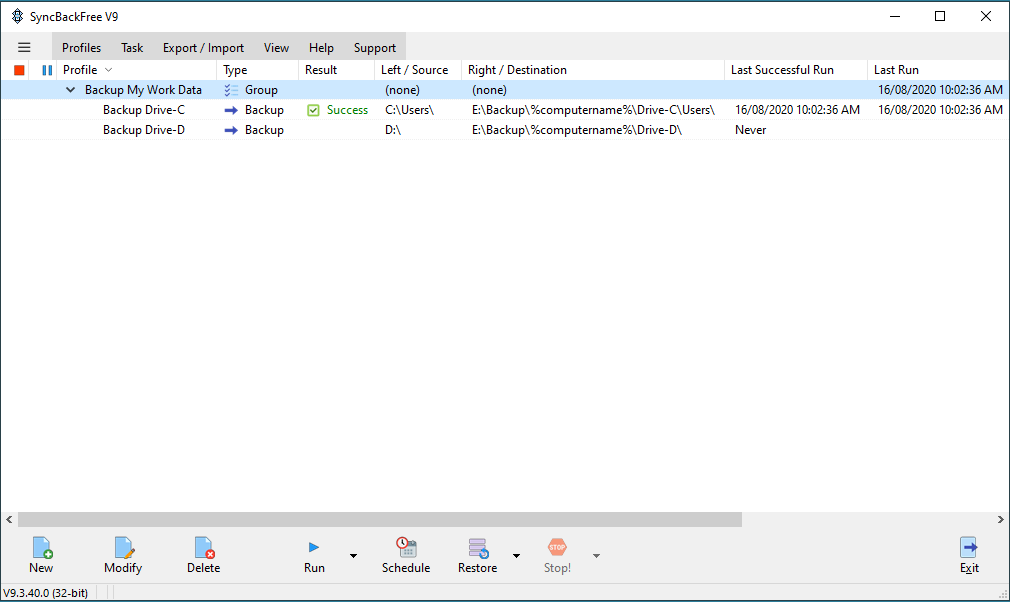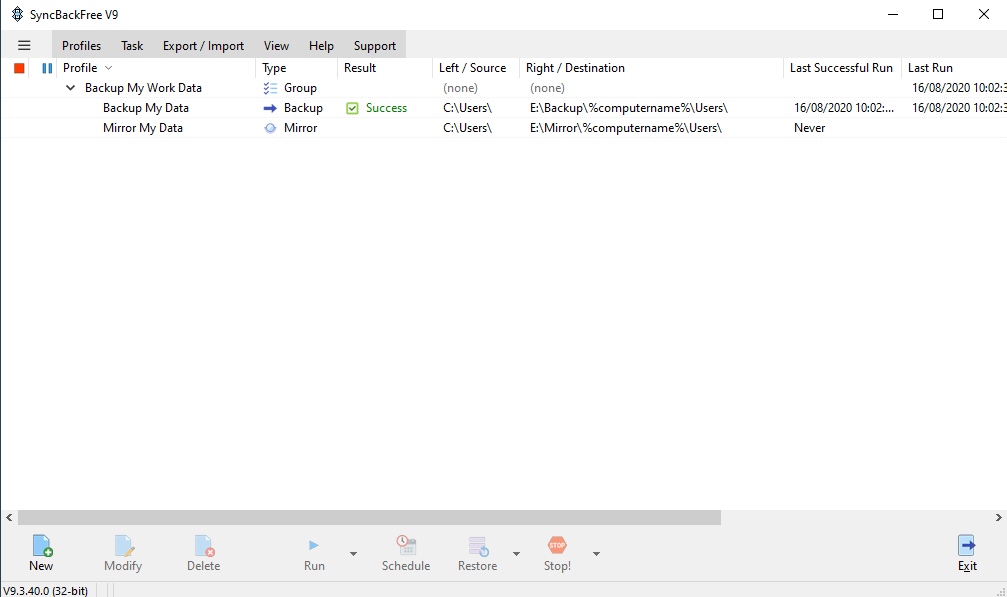User Data Backup Tutorial Part 2
Welcome back.
Post Backup
When your backup is finished keep your USB backup drive close to your PC to remind you to backup on a regular bases. Only plug the backup drive in when you are going to do a backup or restore. If your PC becomes infected with a ransomware encryption virus you will need the backup drive to recover your stuff after the PC has been restored. However, if your backup drive is connected while your PC is infected with ransomware you will loose the backup too.
Backup Session Failure
If your backup session failed you may not have closed all the programs before hand (step 1 from the User Data Backup article). Close all programs and try again. If you have done this and you are still receiving a failure status, restart your PC and try again once the system is up and running.

Fig 1. SyncBackFree failed backup.
In the event that the backup continues to fail after performing the above suggestions, please contact me for further assistance.
Other Backup Profiles
If you have more then one hard drive or hard drive partition you will have two or more backup profiles contained within a group profile.

Fig 2. SyncBackFree group profile for two hard drives or two hard drive partitions.
Select and run the group profile. This in turn will sequentially run each profile listed within the group profile.
Backup and Mirror Profiles
Another type of group profile may contain a "backup profile" and a "mirror profile". A typical user data backup is known as a non-destructive backup. All information copied to the backup drive is never deleted by the running backup profile. This means if you delete a file or folder from from your PC and then run a backup the deleted file or folder will remain in the backup. The same holds true for moving or renaming files and folders.
If you rename a file or folder and run a backup, the previous file or folder with its old name will remain in the backup along with the newly named file or folder. If you move a file or folder and run a backup, the previous file or folder location will remain in the backup along with the moved file and folder. As you can imagine, over time your backup will become messy and will not represent the current state of your PC.
This is good for retrieving lost data from your PC but not so good if you want to restore all your data. If your backup data is quite large in size (hundreds of gigabytes) it is recommended to delete your backup say once a year. This will refresh your backup bring it closer to the current state of your PC.
However, if your backup data is small in size you can run a normal backup profile and a second mirror profile. The mirror profile is a destructive backup, it mirrors the content of your PC. What is on your PC is what is in your mirrored backup. If you delete a file or folder on your PC and run a mirror profile, SyncBackFree will delete the file or folder in the backup. Again same holds true for renaming and moving a file or folder.

Fig 3. Backup and mirror group profile.
Running a backup profile and mirror profile will give you the best of both worlds. If you need to retrieve a lost file or folder look in your backup folder. If you need to restore all your user data onto a restored or new PC, copy it over from your mirror backup folder.
Relocated Users Folder
If your PC contains a solid state hard drive (ssd) and a mechanical hard drive (hdd) your Users folder may be located on the hdd. That is, in a normal installation of Windows, your Users folder is located on drive C: (C:\Users\). Your ssd may be quite small in size (128GB or 256GB) but your user data is large (100GB or more and growing!). Your hdd may be 1TB or more in size. It would make sense to relocate your Windows User folder to the hdd. In this case your SyncBackFree backup profile may show the "Left / Source" path as: D:\Users\.
Restoring Your User Data
The nice thing about SyncBackFree is that it copies your work data without archiving it or trapping it in a proprietary format. You do not need to run SyncBackFree to restore your lost data. You can simply navigate to the backup folder via Windows Explorer and copy/paste your work data. Though you can optionally use SyncBackFree to restore data.
The path to your work data in the backup drive is one of the following:
- <Drive Letter>:\Backup\%computername%\Users\
- <Drive Letter>:\Mirror\%computername%\Users\
- <Drive Letter>:\Backup\%computername%\Drive-C\Users\
- <Drive Letter>:\Backup\%computername%\Drive-D\
Where <Drive Letter> is the drive letter assigned to your USB backup drive when you plug it in.
The %computername% translates to the name Windows assigns your PC. You can find your PC name by right mouse clicking on the "This PC" desktop icon or in the Start menu and select Properties (for Windows7 its the "Computer" icon).
To navigate to your backup data:
- Plug in your USB backup drive, wait until it mounts.
- Open Windows Explorer.
- Open your backup drive.
- Open the Backup or Mirror folder and then the PC name folder.
- If you have only one PC hard drive or one partition, open the Users folder.
- If you have two or more PC hard drives or partitions open either the Drive-C or Drive-D folder.
- If you know where your files and folders live in your PC's hard drive (the pathway to where they live) you will find them in the same place relative to your position in steps 5 or 6.
You can now copy and paste files or folder from the USB backup drive to your PC's drive(s).
